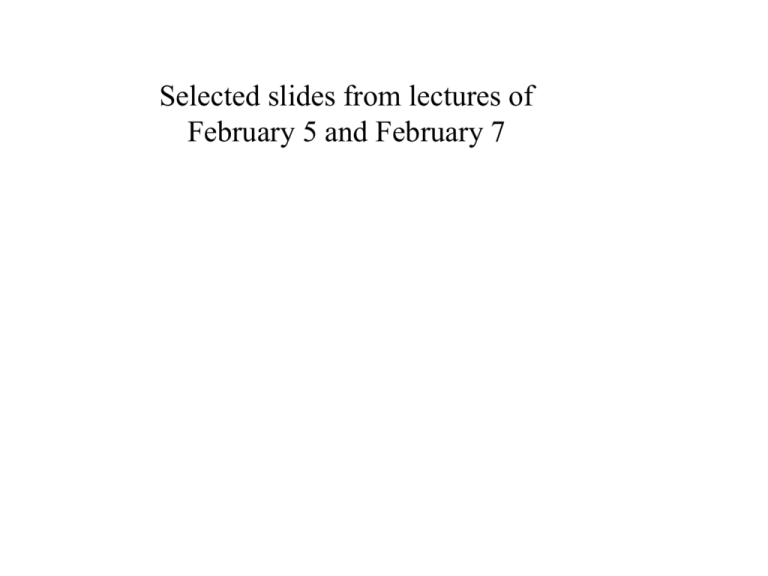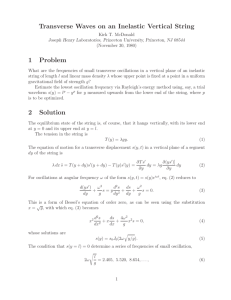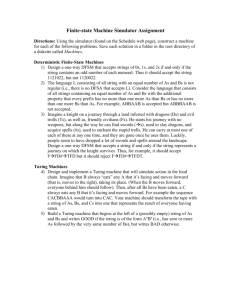presentation source
advertisement

Selected slides from lectures of February 5 and February 7 Superposition of sounds 2/5/2002 Beats two tones of nearly the same frequency - beats. Beat frequency = f1 - f2. 3. INTERFERENCE OF TWO SOUND SOURCES resulting sound is loud or soft depending on difference in distance to the source soft (opposite phase) demo loud (in phase) Superposition - Another Special Case: Two pure tones with "simple" frequency ratio like 2:1 or 3:2 Simple frequency ratios = HARMONY e.g. 2:1 ratio = octave; 3:2 ratio = fifth. resulting tone is periodic find frequency of combined tone! Example: 300Hz +200Hz (frequency ratio 3:2) find largest common multiplier: 100 Hz - why? after 1/100 sec, 300 Hz made 3 full oscillations 200 Hz made 2 full oscillations thus waveform repeats exactly after 1/100 sec. 300 Hz - period = 3.33 msec 200 Hz - period = 5 msec 10 ms Black curve: sum (superposition) of 200Hz and 300 Hz Superposition of 200 Hz + 300 Hz repetition frequency 100 Hz = “largest common multiplyer” t (msec) other examples: 150 Hz and 250 Hz (25/15 = 5/3) rep freq: 50 Hz 120 Hz and 160 Hz (ratio 16/12 = 4/3) 40 Hz Vibration of Strings: 2/7/2002 Travel time along string and back = period of oscillation Time = period = 2L/s “Voicing formula”: Fundamental frequency f1 Remember: s s 1 f1 2L 2L T T m T longer string -> lower f (inverse proportion) higher tension(T) - higher f (square-root proportion) more massive string () - lower f (square-root proportion) EXAMPLES Example 1: the A string (440 Hz) of a violin is 32 cm long. Find the speed of wave propagation on this string. (Answ: 282 m/s) Example 2: piano string 80 cm long, mass 1.4g find frequency if tension is 120N. (Answ: 164 Hz) Example 3: guitar string 60 cm long. Where must one place a fret to raise the frequency by a major fourth (4:3 ratio) (Answ: 45 cm) Example 4: string frequency 300 Hz for T= 40 N. Find frequency for T = 50 N. hint: use proportions! (Answ: 335 m/s) Typical String Tension: Violin strings (G3- D4 - A4 - E5 ) tension 35-62 N for D-string 72-81 N for E-string downward force on bridge about 90 N Piano (grand) up to 1000 N/string HIGHER MODES OF STRING An oscillation is called a “MODE” if each point makes simple harmonic motion mode 1st 2nd 3rd freq fundamental 1st overtone 2nd overtone 1st partial f 1 2nd partial f =2f 2 1 3rd partial f =3 f 3 1 demo: modes of string example: find frequencies of modes oscillations called “harmonics” if frequencies are exact multiple of fundamental Actual string motion: SUPERPOSITION of MODES Demo- click here: Modes Playing Harmonics in Strings (flageolet tones) Homework # 4 Example: 800 Hz string. Place your finger lightly at a point exactly 1/4 from the end of the string What frequencies will be present in the tone? Answer: those modes of the 800 Hz string which have a node where you place the fingerall other oscillations are killed by finger. What are they? Fourth mode, eighth mode, twelfth mode 3,200 Hz 6,400 Hz, 9,600Hz. (Explain on blackboard) Used in composition (e.g. Ravel) Related comment: where you pluck or bow affects mix of partials







